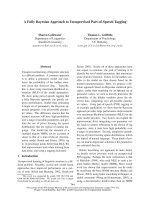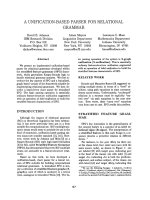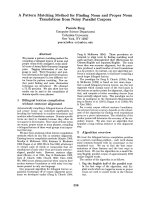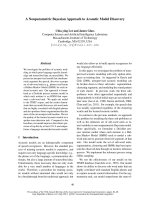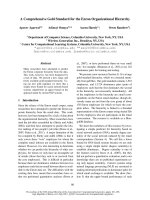Báo cáo khoa học: "A GENERATIVE GRAMMAR APPROACH FOR THE MORPHOLOGIC AND MORPHOSYNTACTIC ANALYSIS OF ITALIAN" ppt
Bạn đang xem bản rút gọn của tài liệu. Xem và tải ngay bản đầy đủ của tài liệu tại đây (508.15 KB, 6 trang )
A GENERATIVE GRAMMAR APPROACH FOR THE MORPHOLOGIC AND
MORPHOSYNTACTIC ANALYSIS OF ITALIAN
Marina Russo
IBM
Rome Scientific Center
via del Giorgione, 129
00147 Rome Italy
ABSTRACT
A morphologic and morphosyntactic analyzer for the Italian
language has been implemented in VM/Prolog
131 at
the IBM Romc
Scientific Center as part of a project on text understanding.
Aim of this project is the development of a prototype which
analyzes short narrative texts (press agency news) and gives a formal
representation of their "meaning" as a set of first order logic
expressions. Question answering features are also provided.
The morphologic analyzer processes every word by means of a
context free grammar, in order to obtain its morphologic and
syntactic characteristics.
It also performs a morphosyntactic analysis to recognize fixed
and variable sequences of words such as idioms, date cxpressi{~ns,
compound tenses of verbs and comparative and superlative form~ of
adjectives.
The lexicon is stored in a relational data base under thc control
of SQL/DS [2], while the endings of the grammar are stored in thc
workspace as Proiog facts.
A friendly interface written in GDDM
[11
allows the uscr to
introduce on line the missing lemmata, in order to directly ulxlatc thc
dictionary.
Introduction
About thirty years ago, the development of decripting tccniques
made computer scientists be involved for the first time in the field of
Linguistics, especially in automatic translation matters.
The failure of most of these projects contributed to a general
sensibilization towards natural language problems, and gave rise to a
variety of formal theories for their treatment.
In the last few years, one of the main research objectives ix-came
the design of systems able to acquire knowledge directly from fcxts.
using natural language as an interface between man and machine.
At the IBM Rome Scientific Center a system has been developed
for processing Italian texts. The task of the system is to
• analyze short narrative texts (press agency news) on a restricted
domain (Economics and Finance),
• give the formal representation of their "meaning" as a set of first
order logic expressions, stored in a knowledge base,
• consult this knowledge base in order to answer any qucstlon
about the contents of analyzed texts.
The system consists of:
• a mmphologie analyzer based on a context-free logic grammar
with the "word" as axiom and its possible components as
terminal nodes. It.includes a lexic9n of about 7000 elementary
lemmata, structured in a table of a relational data base under the
control of SQL/DS.
* a morphosyntaetic analyzer realized by three regular grammars,
recognizing respectively compound tenses of verbs (e,g.
ha.~ been
signed),
comparative and superlative forms of adjectives (e.g. Ihe
most interesting)
and compound numbers (e.g.
three billions .~64
millions 234.000).
This module reduces the number of possible
syntactic relations among the words of the sentence in order to
simplify the task of the syntax.
* a syntactic parser developed by means of a meta-analyzcr [6[
which aUows to write production rules for attribute gntmmars,
and generates from these the corresponding top-down parser. A
grammar has been written to describe the fragment of Italian
consider.~l.
• a semantic la'oe~sm • based on the Conceptual Graphs formal;sin
[10] and provided, with a semantic dictionary containing at
present about 350 concepts. Its task is to solve syntactic
ambiguities and recognize semantic relations between
the words
of the sentence
191.
This paper deals in particular with the structure of the lexicon
adopted in tht: system and with the morhologic and morhosynlactic
analyzer.
In this system the morphology and the lexicon are strictly
combined; for this reason this lexicon does not contain semanlic
information. In the approach of Alinei [4], on the contrary, lexicon
structures contain semantic information in order to describe every
word also in te~qns of its "meaning"
Another possible approach is the one adopted by Zampolli who
developed a frequency lexicon of Italian language at tile
Computational Linguistic Institute in Pisa [5]. The lexicon realized
by ZampoUi's working group containes morphologie hints in order to
guide directly the analysis of every word, without the support of a
morphologic p~ rser.
in most of the works referring to English language morphology is
considered onl) as a part of the syntactic parser. On the contrary.
Italian morpho'ogy requires to be previously analyzed because it is
more complex: there are more rules than in English and these rides
present many exceptions.
For this reason, in the last few years Italian researchers began to
face systematically these problems beside a purely linguistic conlcxk
A procedural approach is the one followed by Stock in the
development of a morphologlc analyzer realized for lhe
"Wednesday2" parser I 11[.
A different approach makes use of formal grammars to describe
the rules of Italian morphology. This morhologic analyzer is based
on a context free grammar describing the logic rules for the word
generation. Other two morphologic systems have been developed
according to the ATN formalism (Augmcuted Transition Network).
The fast one has been realized at the CNR Institute of I'is~ by
Morreale, Campagnola and MugeUesi, as a research tool for teaching
Italian morphology, with applications in automatic processin¢ of
32
natural language and knowledge representation 18]. The second one
has been realized by Delmonte, Mian, Omologo and Satta, as part of
a system for the development of a reading machine for blind people.
171.
In the first section of this paper there is a brief discussion atx, ut
morphologic problems and about the possible approaches to their
solution.
The next section describes the structure adopted for the lexicon
and the other sets of data.
The third section deals with a preanalyzer, which simplifies the
work of morphologie analysis by recognizing standard sequences of
words, as idioms and date expressions.
In the fourth section the morphologic analyzer is described and
in the last one the morphosyntactic analyzer, both realized by means
of context free grammars.
The problem
The aim of morphology is to retrieve from every analyzed word
the lemma it derives from, its syntactic category (e.g.
verb,
un,
adjective, conjunction
) and its morphologic catego~ (e.g.
masculine, singular, indicative ).
A possible approach to the problem is to store in a data base a
list of all the declined forms for every lemma of the language, as well
as their morphologic, syntactic and semantic characteristics.
The size of such a list would be enormous, because a common
dictionary contains about 50000-100000 lemmata and each lemma
gives rise to several derived words and each word may be declined in
different ways.
Such a large data base is hard to enter and to update, and it is
limited by the fixed size of its words list.
In Italian, the creation of words is a generative proces~ ~hat
follows several roles like, for instance:
HANO
(hand)
> verbalization > HAN-EGGIARE
(to hand-le)
> composition > PALLA-MANO
(hand-ball)
> olitlcization > RI-MAN-EGGIARE
(to re-hand-le)
In English, rules like composition or cliticization are not strictly
morphologlc, because they often involve more than a word. In
Italian, on the contrary, they modify the single word, producing new
words like, for instance:
> alteration > CART-ACCIA
(waste paper)
CARTA > composition > CARTA-MONETA
(paper) (paper money)
> cliticization > IN-CART-ARE
(to wrap in paper)
These rules make the set of Italian words potentially unlimiled,
and sometimes make insufficient even a common dictionary.
A different approach takes two different lists: one containing the
lemmata of the language and the other the logic rules of derivations,
from which all the correct Italian words can be produced starting
from the lemmata.
These rules can be
easily described by means of a context-free
grammar, in which every "word" results from the concatenation of
the "stem" of a lemma with alterations, affixes, endings and enelities.
This grammar can both
generate
from a given lemma all the
current Italian words deriving from it and
analyze
a given word by
giving all the possible lemmata it derives from.
The backtracking mechanism of Prolog directly allows to obtain
all the solutions.
This morphologic analyzer can also provide further information
about some linguistic peculiarities, like, for instance:
compound names
modal verbs
altered names
pelle-rossa (red-skin), which has as plural
peUi-rosse.
which take another verb as object (1 can
go)
foglia
(leaf) can be altered in
fogli-olina
(leaf-let), whose meaning is
piccola foglia
(small leaf).
Data structure
A correct morphologie analysis requires not only knowledgc on
the language lemmata, but also on the word components as
alterations, affixes, endings and enclitics. This information might hc
represented in form of Prolog facts. In this way, data mighl be
directly accessed by the program, because the homogeneity of their
structure. The disadvantage is a performance degradation when the
size of data increases, since Prolog is not provided with efficient
search algorithms.
Hence it seemed convenient to draw a distinction between data:
on one hand the set of lemmata, and on the other the sets of affixes,
alterations, endings and enclitics. The former (which is the most
relevant and needs to be continuously updated), has been struclurcd
as a relational data base table, managed by the SQI,/DS. The
advantage is that this system is directly accessible from VM/Prolog
(the string containing the query is processed by SQI., which returns
the answer as a Prolog list). The latter (which have fixed lenghl and
are not so large), have been stored in the Prolog workspace i, f, rm
of Prolog facts.
The set of lemmata is a table with five attributes:
1. the fu'st is the lemma.
2. the second is the stem (the invariable part of the lemma): this is
the access key in the table.
3. the third is the name of the "class of endings" associated with
every lemma. A class of endings is the set of all the endings
related to a given class of words. For example, each of the
regular verbs of the first conjugation has the same endings; hence
there exists a class named
dv_leonjug
containing all and only
these endings. Generally each irregular verb is related to different
classes of endings: andare
(to go),
for example, admits two
different stems, vad (go) and and
(went);
so there exist two
subclasses of endings named respectively
dvl andare
and
dr2 andare.
4. the fourth attribute is the syntactic category of the lemma: Ior
example, the information that
to have
is an auxiliary transitive
verb.
5. the fifth is an integer identifying the type of analysis Iobc
performed:
I the analysis can be performed completely
2 the lemma can neither be altered nor affixed (this is
the case for example of prepositions and
conjunctions)
3 only the longest analysis of the lemma is considered
(this is the case of the false alterated nouns:
mattino
(morning)
is not a little matto
(mad),
such
as in english
outlet
is not a little
out!)
33
lemma I stem ending dam synt=categ label
matte matt
da_bello
adj.qualific. 1
mattino mattin dn_oggctto noun.common 3
di di prep.simple 2
andare vad dv 1 _andare v.intran.simple 1
andare and I dv2. andar© v.intran.simple I
The other
sets
of data are contained in the Prolog workspace and
are structured as tables of a relational data base.
The set of the classes of endings is a table with three attributes:
l.
2.
3.
the
first is
the
name of
the
class and it is the access key in the
table.
the second is one of the endings belonging to the class
the third is the morphologic category associated with the ending:
for example, the class dn oggetto contains the two endings which
are used in order to inlleet all the masculine nouns behaving like
the word oggetto (object): o for the singular (oggett-o), and i for
the plural (oggett-O.
eading da~ ending morph_categ
dn_oggctto
o
mas.sing.
dn_oggetto i mas.phir.
The affixes can be divided in la'eflxcs preceding the stem of the
lemma, and suffixes following the stem of the lemma.
The prefixes are simply listed by means of a one attribute table.
In this way it is not necessary to list the prefixed words in the
lexicon: they are obtained by chaining the prefix with the original
word. For example, from the verb to handle with the prefix re we
obtain the verb to rehandle. Morphologlc and syntactic
characteristics remain the same; for the verbs only, the prefixed verb
differs sometimes from the previous one in the syntactic atlribules
(transitive/intransitive, simple/modal).
The set of suffixes is a table with four attributes:
I.
2.
3.
4.
the first is the suffix itself
the second is the stem of the suffix (the access key to the table)
the third is the ending class of the suffix
the fourth is the syntactic class of the suffix. Suffixcs, in fact,
differently from prefixes, changes both morphologic and syntactic
characteristics of the original word: they change verbs into names
or
adjectives
(deverba/suff'oces), names into verbs or adjectives
(denominal suffixes), adjectives into verbs or names (deadje:tival
suffixes). The first attribute is chained to the stem of the original
lemma in order to obtain the derived lemma: for example, from
the stem of the lemrna mattino (morning), which is a noun, with
the suffix iero, we obtain the new lemma mattin-iero (early
rising), which is an
adjective,
and from the second stem of the
lemma andare (to go), which is a verb, with the suffix amento,
we obtain the new lemma and-amento (walking), which is a
noun.
suffix
iero
amento
stem ! endingdam
ier da bello
ament I dn_oggetto
synt_catcg
adj.qualific.
noun.common
The set of alteration is a table with three attributes:
1. the first is the stem of the alteration (the access key in the tablc l
2. the second is the ending class of the alteration
3. the third is the semantic type of the alteration. Alterations
change the morphologic and semantic characteristics of the
altered word, but not its syntactic cathegory: for example, the
lemma easa (house) can be altered in casina (little house),
easona (big house), easaeeia (ugly house), and so on:
stem endinLda.~ seman categ
in da belle diminutive
on dn_cosa augmentative
acc
da_~bio pejorative
The cnclitics are pronouns linked to the ending of a verb: for
example va li" (go there) can be expressed also in the form vaeei (ci is
the ¢nclitic, the c is duplicated according with a phonetic rule).
The set of the enclitics is a table with two attributes: the first is
the maclitic (this is the access key to the table) and the second is the
morphologlc characteristic of the encfitic. The analy-zer divides the
verb from the enclitic, so that it becomes a different word, taking the
morphologlc characteristic stated in the table and the syntactic
category of pronoun.
Other two sets of data have been defined in order to handle fixed
sequences of words, such as proper names and idioms.
The set of the most common italian idioms has been structured
as a table with two attributes: the first one is the idiom itself, while
the second is the syntactic category of the idiom. In this way it is
possible to recognize the idiom without performing the analysis of
each of the component words. For example, di mode che (in such a
way as) is an idiom used in the role of a conjunction, and a mane a
matzo (little by little) is used in the role of an adverb.
The set of proper names belonging to the context of Economics
and Finance is a table with three attributes: the first is the proper
name, the second its syntactic category and the third its moq~hologic
category.
proper n~llrle
lunedi' (monday)
synt_categ morph_catcg
mas.sing. name.prop.wday
Montcpolimeri Montedison name.prop.comp, fern.sing.
Vittorio Ripa di Meana name.prop.pers, mas.sing.
Regglo Emilia name.prop.lee, fern.sing.
The Preanalyzer
The preanalyzer simplifies the work of analysis recognizing
all
the
"fixed" sequences of words in the sentence.
Fixed sequences of words arc, for example, idioms like in such a
way as. To analyze this sequence of words it is not necessary to
know that in is a preposition, such is an adjective, a an article, and so
on: the only useful information is that this sequence takes the role of
conjunction. Other fixed sequences of words are proper names: it is
necessary to know, for example, that Montepolimeri Montedi.wn or
Vittorio Ripa di Meana are single entities.
Idioms and proper names are recognized by means of a pattern
matching algorithm: the comparison is made between the
lll|,tll
sentence and the first attribute of the tables of idioms and proper
names. When the comparison fails, backtracking evaluates another
hypothesis. Every recogniz~ed sequence of words is written on an
appropriate fde and then removed from the input sentence.
Date expressions, as lunedi' 13 agosto
(monday, august tile /3rd),
arc
considered as single
entities, in
order to simplify the work
of
syntax. They are recognized by means of a context-free grammar,
34
whose
axiom is the "date':
I DATE > <name_proper_wday> <DAI>
2 DATE > <DAI>
3
DATE > <DA2>
4 DAI > <number(<31)> <nameproper_month>
5
DAI > <number(<31)> <DA2>
6
DA2 > <nameproper_month> <number>
Figure I. The grammar for the DATE
Numbers are
recognized by
the library function
numb(*)
and by
means of a context-free grammar translating strings into numbers. In
this way it is possible to evaluate in the same way expressions such
as 1352 and milletreeentoeinquantadue
(one thousand three hundred
and fifty two).
i NUMBER
> <NUMI>
2 NUMBER
> <'mille'>
3 NUHBER
> <'mille'> <NUHI>
4 NUMBER
> <NUHI>
<'mlla'>
5 NUMBER
> <NUHI> <'mila'> <NUHI>
6
WdH1
><NUH2>
7 NUH1 ><NL~3>
8 ICu~ll > <NUH4>
9
NUH2
> <units> <NUH3>
I0 NUH3 > <'cento'>
11 NUM3 > <'cento'> <NUM4>
12 NUM4 > <units>
13 NUH4 > <tens>
14 NUH4 > <tens> <units>
Figure 2. The grammar for the NUMBER
The morphologic analyzer
This is the main module of the whole system. Its task is to
analyse each element (word) of the list received from the preanalyser
and to produce for every form analyzed the list of all its
characteristics:
I. the lemma it derives from
2. its syntactic characteristics
3. its morphoiogic characteristics (none for invariable words)
4. the list of alterations (possibly empty)
5. the list of enclitics (possibly empty).
For example the form sono (the ist sing. and the 3rd plur. person
of the present indicative of essere, to
be),
after the analysi~ is
represented by the list:
( S ono.
(V. int ran. aux. ind. pres. act. 1. sing. es s ere. n i 1 ).
(v. int ran. aux. ind. pres. act. 3. plur. essere, nil ).
nil)
Every Italian word is made up by a fundamental nuclc,s, tile
stem
(two for the compound names). This is preceded by one or
more
prefixes,
and followed by one or more
suffixes
and
alterati,,ns,
by an
ending
and, as far as the verbs are concerned, by one or more
enclitics.
This structure has been described by means of a context-free
grammar in which the "word" is the axiom and all its comlxmcnts
the endings.
1 WORD > {prefix'} n <stem> <REM>
2 REM > {suffix)'* {alteration} n <TALL>
3 REM > <ending> {suffix}" {alteration}" <TAll.>
4 TAIL > <ending> {enclitic} n
Figure 3. The grammar for the WORD
tlere are some example of words analyzed with this grammar:
muraglione (high wall)
tour is the stem of the word muro (wall)
agl is the stem of the suffix
aglia
i-on on
is the stem of the alteration
one
(augmentative):
the i is an euphonic vowel
e is the ending of the singular.
I~RD
R~
2
suf~AIL
agl Ion en~ng
I
stem
I
llur
Figure 4. Parse tree for the word MURAGLIONE
trasportatore (carder)
tras is the prefix
port is the stem of the verb
portare
(to carry)
at is the ending of the past participle of the verb
or is the stem of the deverbal suffix
ore
e is the ending of the masculine singular.
prefix
tr! port ending sufflx T~L
I I .oL
at or
I
e
Figure 5. Parse tree for the word TRASPORTATORE
35
ridandoglido (giving
h
to him/her again)
rl
is the prefix (R means again)
d is the stem of the verb dare (to give)
ando is the ending of the present tense of gerund of the
verb
glie is the first enclitic (it means to ~tim~he,): e is an
euphonic
vowel
Io is the second enclitic (it means it).
UD
prefix
stem
1 1 ,L
ri cl
e~tlc
I [ I
ando g~
lo
Figure 6. Parse tree
for
the
word
RIDANDOGLIELO
The compound nouns are not reported in the lexicon: they arc
derived from "the two component lemmmata. Their plural is made
according to the following set of rules:
1V+
2V+
3V+
4V+
5N+
7 6 Adj
N+
N(mas.slng)
>
Noun's ending changes
N(fem.slng) > no ending changes
~
(plur) > no ending changes
> no ending changes
N > 2nd Noun's ending changes
+ N > Noun's ending changes
AdJ > both endings change
Figure 7.
The rules for the plural
of Compound
Nouns
Some examples of compound nouns are:
singular plural
passa-porto (pass-port) passa-porti
porta-cenere (ash-tray) porta-cenere
cava-tappi (cork-screw) cava-tappi
rule
1
2
3
4
5
6
7
sali-seendi
(door-late~t) sali-mendi
banco-nota (bank-note) banco-notc
basso-rilievo (bas-relieJ) basso-rilievi
cassa-forte (steel-safe) casse-forti
The
task
of
this
part of the morphology is to:
reeoguize all the "well-formed" words of Italian language.
The analyzer parses the words from left to right, splitting them
into elementary parts: prefix(es), the stem(s) of the appropriate
lemma(ta) of derivation (retrieved from a restricted dictionary
reporting only the "elementary lemmata') suffix(es), alteration(s),
ending(s), enclitic(s). Each hypothesis is checked by verifying
that all the conditions for a right composition of those parts are
satisfied.
2. submit every word not recognized to the user, who can state
wether:
® the word is really wrong, because of
- an orthographic error: for example squola instead of scuola
(school).
- a composition error: for example serviziazione is wrong as
'iazione' is a deverbal suffix and 'serviz" is the stem of the
noun 'servizio' (service) and the corresponding verb does not
exist.
a the word derives from a lemma which is not reported in the
lexicon. In this case the user can recall a graphic interface,
allowing him/her to update directly the lexicon.
3. perform, if requested by the user, an inspection in the list of the
"currently used" words. In this way, for example, the user knows
that coton-~eio (cotton-mill) and coton-iera are two well-formed
Italian words, but that only the first one is commonly used.
The morphosyntactic analyzer
The aim of the morphosyntactic analyzer is to perform the
analysis of the contiguous words in the sentence, in order to
recognize regular structures such as compound tenses of verbs and
comparative and superlative forms of adjectives.
Compound tenses of verbs are described by means of a regular
grammar, whose rules are applied any time the analyzer finds in the
sentence the past participle of the verb. These rules arc:
I C0MP:ZNSZ
2 COMP TENSE
3 REM
4 REM
5 REM
> <v.tran.aux.>
<v. tran.(past.part.)>
> <v.intran.aux.> <REM>
> <v.intran.aux.(past.psrt)>
<v.tran.(past.part)>
> <v.tran.(past.part)>
> <v.intran.(past.part)>
Figure 8. The grammar for the COMPOUND TENSEs of verbs
When a rule is successfully applied the morphologic categories of
the verbs are changed and the attribute 'active'/'passive' can bc
specified correctly. For example, after the morphosyntactic analysis.
the phrase
io suno chiamato
(I'm called)
((io.
(pron. pets. 1. sing. io. nil).
nil).
( s ono.
(v. intran, aux. ind. pres. act. 1. sing. essere, ni I ).
(v. int ran. aux. ind. pres. act. 3. plur. essere, ni ] ).
nil).
(ehiamato.
(v. tran. sire. part. past. act. mas. sing. chiamare, ni I ).
nil).
nil)
becomes
((io.
(pron. pers. 1. s ing. io. nil).
nil).
(
sono_chiamato.
(v. tran. s ]an. pass. ind. pres. 1. sing. chiamare, ni I ).
nil).
nil).
in which only the fu-st analysis of the word "sono" has been taken, as
the number of the auxiliary verb must correspond to the nu,nber of
the past participle. The form is passive, as "chiamare" (to call) is a
transitive verb (the auxiliary verb for the active form is to have). In
36
this case morphosyntactic analysis has solved an ambiguity: only an
interpretation will be analyzed by syntax.
The following figure shows the task of the grammar, applied any
time the parser finds the past participle of a verb in the sentence.
® If the verb is transitive the parser looks at the word BF.FORE
the verb:
-
if the word is a tense of the verb to be, the resulting verb is
SIMPLE PASSIVE (the rules applied are the 2nd and the
4th);
-
if the word is a tense of the verb to have, the resulting verb is
COMPOUND ACTIVE (the rule applied is the lst).
u If the verb is intransitive the parser looks at the word AF'I'FR
the verb:
- if it is the past participle of another verb the resulting vcrh is
COMPOUND PASSIVE (the rules appfied are the 2nd and
the 3rd);
- otherwise it is COMPOUND ACTIVE (the rules applied arc
the 2nd and the 5th).
pIIIT IMATImlq8 l
i ' i I "- i
2,4 1 2.3 2.8
Figure 9. Compound tenses of verbs
The grammar for the comparative and supcrlativc forms of
adjectives is applied any time the analyzer finds thc words piu'
(more),
meno
(less)
followed by a qualificative adjective. In this way
it is possible to recognize and to distinguish expressions like piu'
interessante
(more interesting)
and il pin' interessante
(the most
interesting).
Remark that in English there is the use of
more, most
to
make cleat the distinction between the comparativc and the
superlative form of the adjective.
1
SUPERL REL > <art.determ.> <COMPARATIVE>
2 C0MPAI~TIVE > <'piu"> <adj.qualific.>
3
COHPARATIVE > <'meno'> <adj.quallflc.>
Figure 10. The grammar for the SUPERLATIVE and COMPARATIVE
form of adjectives
In the same manner it is possible to recognize mixed numeric
expressions like
three billions 564 millions 234000
and to cwduate
thcrn into their equivalent numeric form
(3564234000).
The talcs arc
applied any time the analyzer finds the words miliardi
(billions),
milioni
(millions) in
the sentence.
1 NUH COMP > <agg.num> <'mlllardo'> <NUHI>
2 NUH-COMP > <agg.num> <'miliardo'> <agg.num>
3 NUH_-COHP > <agg.num> <'mlliardo'>
4 NUH COMP > <NUHI>
5 NUHT > <agg.num> <'millone'> <agg.num>
6
NUH1 > <agg.num> <'millone'>
Figure
II. The grammar for COMPOUND NUMBERs
Conclusions
This approach presents the advantage of a higher flexibilily in the
analysis of words. Moreover such a method has requested a strong
initial effort in the formalization of the rules (with all their
exceptions) for the morphologic treatment of words, but has largely
simplified the work of classification of every Italian word.
The lexicon stores about 7000 elementary lemmata, derived from
a list of about 20000 different Italian forms. They correspond to
about 15000 ordinary lemmata (entries of a common dictionary).
References
[1] Graphical Data Display Manager,
Application Programming
Guide,
SC33-0148-2, IBM Corp., 1984.
[2] SQL/Data System,
Terminal User's Reference,
SII24-5fU7-2,
IBM Corp., 1983.
[3] VM/Programming in Logic,
Program Description/Operation
Manual,
SH20-6541-0, IBM Corp., 1985.
[4] M.Alinei, La struttura del lessico, ed. II Mulino, 1974.
[5] U.Bortolini, C.Tagliavini and A.Zampolli, Lessico di freq.enza
delia lingua italiana contemporanea, ed. IBM, 1971.
161
B.Bottini and M.Cappelli, Un Meta Analizzatore Orienial. al
Linguaggio Natnrale in Ambiente Prolog,
M.D. Thesis.
Mihlno.
1985.
171
R.Delmonte, G.A.Mian, M.Omologo and G.Satta, Un
riconoscitore morfologico a transizioni aumentate,
Proceedio, es
of AICA Meeting,
Florence, 1985.
181
E.Morreale, P.Campagnola and R.Mugellesi, Un sislema
interattivo per il trattamento morfologico di parole italiane,
Proceedings of AICA Meeting.
Pavia, 1981.
191
M.T.Pazienza and P.Velardi, Pragmatic Knowledge on Word
Uses for Semantic Analysis of Texts,
Workshop on (;'onCel,tl~al
Graptu,
Thornwood, NY, August 18-20 1986.
[10] J.F.Sowa, Conceptual Structures: Information Processing in
Mind and Machine,
Addison-Wesley,
Reading, 1984.
I111
O.Stock, F.Ceceoni and C.Castelfranchi, Analisi morfoh~iea
integrata in un parser a coeoscenze linguistiche dislribuitc,
Proceedings of AICA Meeting,
Palermo, 1986.
37



